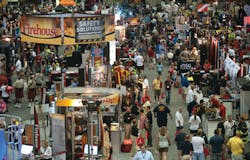Not all the training at Firehouse Expo in Baltimore was in the conference room. In fact, there was plenty of learning happening on the exhibit floor as well. One of the classes on the trade show floor was about electric plug-in cars and hazards they present to responders.
Coverage of Firehouse Expo 2011
The classroom right on the show floor is a new feature of this year’s event. One of Thursday’s instructors was Ron Moore, a battalion chief with the McKinney (Texas) Fire Department and a long-time Firehouse writer, and author of the University of Extrication series in the magazine and on Firehouse.com.
In an hour-long presentation, which included a $1 million cut-up prototype Chevy Volt as a learning prop, Moore gave a spirited presentation on the things that can bite firefighters and EMS personnel in electric plug-in vehicles.
“By 2012, these will be in every state,” Moore said, noting that there has been a steady roll out of electric plug-in vehicles from two major manufacturers, Chevrolet and Nissan. “They’re going full blast now."
Each of the two vehicles, the Volt and Nissan’s Leaf, have two electrical systems, one that is purely high-voltage, up to 400 volts, used to propel the vehicle and another 12-volt system that is used much as a conventional vehicle to power accessories and lights.
“You must disconnect both,” Moore said to the more than 200 people gathered to listen to his words of wisdom.
Throughout the presentation, Moore had several tips that he called “teaching points.” Among those were the paramount need to make sure the vehicle is completely off while tending to patients or trying to make extrications. He said both the Volt and the Leaf have keyless, push-button “start” systems that can be de-activated by pushing the button on the dash or console once, if the vehicle is still on. Both vehicles’ start mechanisms are illuminated, although Moore said neither is easy to see, especially in daylight.
Moore said both vehicles, which are not to be confused with hybrid vehicles, like the Toyota Prius, have master disconnects which are plugs in the center tunnel of the car accessible from inside the vehicle. It’s also important to cut the 12-volt battery systems as well in accordance with manufacturers’ requirements.
In both the Volt and the Nissan, the batteries are under the vehicle and cribbing and jacking is not recommended, Moore said.
“You will puncture the batteries if you do that and that would not be a good thing,” he said. There are places were vehicles can be jacked and he recommended firefighters visit a dealership to crawl around under the rigs to get an idea where jacking can be done safely. He commented that the manufacturers do not offer suggestions on that score.
The batteries in the plug-in vehicle are remarkably different, he said, noting the Leaf and Nissan use lithium ion batteries, not the nickel hydride batteries found in hybrid vehicles.
“If you ever come across one of these that are burning, you must wear full packs,” Moore said, noting that respiratory protection is essential. “It will be a respiratory problem. We are talking lethal, lethal gases. It’s a very big deal. Pack up and keep it on to the very end when it’s completely cooled and there are no more fumes or vapors coming off of it.”
The hybrid vehicles are built a little tougher, at least the Volt, than many other cars on the road, Moore said, which presents further challenges for responders.
High tech designs and boron steel make the older extrication tools obsolete, Moore said. “If you have older equipment, you will not be able to cut this B-pillar,” Moore said, holding up the previously removed pillar from the silver Volt on the exhibit floor.
That, however, doesn’t mean rescuers can’t do anything. Moore said the roofs of the Volts are good, old-fashion sheet steel which can be cut with an ordinary reciprocating saw. By removing the roof, Moore said some of the structural integrity of the vehicle has been removed and the B-pillar can then be spread and bent away from the victim with extrication rams.
Doors, hinges and latches remain the same as other vehicles on the road today, so popping a door for patient extrication shouldn’t be any difficulty, Moore said.
In concluding his presentation, Moore offered the National Fire Protection Association’s (NFPA) training program and web site as a resource to learn more about electric vehicles and hybrids.
Using money from a federal grant, NFPA has developed response plans and training for the increasingly popular electric vehicles on the road today, Moore said.
“I would encourage you to go visit them or go their web site,” Moore said.
The training can be found at www.evsafetytraining.org.






